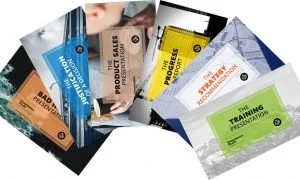The 3 Legs of the Better Presentation Stool


Do your company presentations hit the spot each and every time? Be honest. If the answer’s no, you may be pleased to know you’re not alone but that doesn’t solve the problem. Nolan Haims suggests a three-pronged (or -legged) approach that will ensure continued success but – spoiler alert – it will require discipline. Empowering and supporting your team will be worth it when you see the results.
I often receive calls from frustrated organizations that have had it with employees creating inconsistent and poorly designed presentations. Desperate to improve the professionalism of their presentations, they usually ask if I can either provide training or create a template that will solve all of these problems. In each case, I gently explain that any one strategy isn’t good enough on its own to solve their problems.
Dramatically improving the consistency and quality of an organization’s presentations involves a three-pronged approach. To use a tired metaphor, good organizational presentation is a three-legged stool:
- Smartly built template system, boilerplate collection and assets
- Customized training in both the use of the template and in general best presentation practices
- An internal presentation police force to enforce standards
Take away any of these three legs, and somebody’s going to fall on their ass.
1) A smartly built template system, boilerplate collection and assets
There’s no reason why anyone in an organization should be creating a new look and feel for an everyday presentation. There should always be available a properly built presentation template that adheres to brand standards and exploits PowerPoint’s features to make it easier to build, design and format slides (color and font themes, default shapes, master layouts, etc.) The template should not only have standard layouts, but custom ones relevant to the organization’s business. Always needing to compare two charts to one another? You should have a layout for that.
In addition to mastered layouts, a good template system should have a healthy collection of well-designed boilerplate slides ready to drop into new presentations. Always needing to show a timeline or org chart? Those should be readily available and ready to be updated with new content. No reinventing the wheel each and every time!
Along with boilerplate slides, an organization should have a collection of ready-to-use assets such as a custom icon library, a chart library perhaps and a legally usable photo library. These items can be contained within a single PowerPoint file or separately on a server.
Lastly, an organization may choose to invest in custom macros, add-ins and other software that greatly improves efficiency such as automatically inserting certain company content or managing vast libraries of slide content.
2) Customized training in both the use of the template and in general best presentation practices
All the above tools and assets are useless if users have no idea how to use them. You spent a fortune on a stock imagery collection? Great, it doesn’t matter if nobody knows where to find it and how to insert the images properly into the template.
And so, users need training in how to use the tools you have created for them. But just knowing the ins and outs of the template still won’t make a good presentation designer. Users will also need training in what makes good visual communications, why and how to reduce text on slides, how to work with imagery, how to design effective charts and more.
The goal here is not to produce professional graphic designers, but to give average users an understanding of the basics, so they don’t keep creating eye charts and using every color in the rainbow for their bar charts.
3) An internal presentation police force to enforce standards
And now we come to perhaps the hardest part of all. Even though you have a well-trained staff with assets at their fingertips, this does not mean that your staff will never take shortcuts, get sloppy and forget what they learned. And each time that happens and nobody calls them on it, the slide back to bad presentation world will continue until it hits another boiling point.
I’ve spoken to many presidents and CEOs who have bemoaned bad decks coming out of their company, but feel as though an outside influence (i.e. training, template design) is the only solution. In these situations, I explain that they simply need get tough and be a disciplinarian.
It’s not the CEO’s job to police every single deck that is created, but it is his or her job to make it known to directors and managers what is expected in terms of consistency down through the company. At each level, employees should be advised and cautioned on creating presentations consistent with company standards.
This type of policing is done all the time in other areas of the company: dress codes, hiring practices, social media guidelines, what can be said to reporters, profit margins that need to be maintained. Working for a company doesn’t entitle one to absolute freedom of expression when representing that company. And yet is sometimes seems that way with presentations.
Does #3 sound overly militant? Well, if you don’t want to hire police to catch speeders, don’t bother putting up speed limit signs.
If you liked this, you might also like:
A recipe for an efficient corporate PowerPoint template












Jim Harvey
30th March 2017 at 9:26 am
Great post Nolan. It’s surprising how often you find total disarray in presentation & pitch materials at even the largest and most successful businesses. Great tips.
Nolan Haims
30th March 2017 at 3:06 pm
Thanks, Jim!